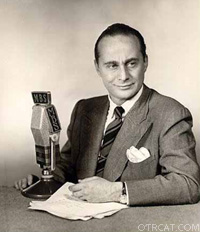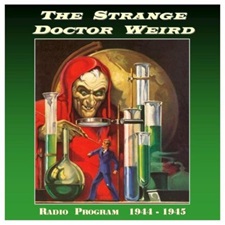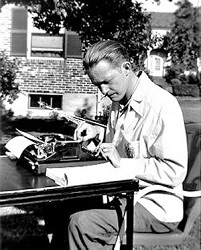
 The Strange Dr. Weird (1944-45) aired “The Man Who Talked with Death” on December 12, 1944 as the 6th episode of 28. We have run only nine earlier episodes of this show since 2018, the last two from January and June of 2024. The show ran from November of 1944 through May of 1945 in short 15-minute episodes (a few minutes less without commercials), and was dubbed by some as a poor man’s Mysterious Traveler. Indeed, there are similarities between the shows, though MT had a much longer run of nine years (1943-52) and was a full half-hour program. Maurice Tarplin (photo at right, 1911-1975) was the host/narrator for both shows, and one of the writers for MT, Robert A. Arthur (photo lower right, 1909-1969), also penned the scripts for The Strange Dr. Weird. While MT’s shows included tales of mystery and suspense along with SF and the supernatural, The Strange Dr. Weird concentrated mostly on the supernatural. Both shows opened with the narrator setting the stage with a tease for what was to follow, but where MT stories were told in conversation while on a train and ended with the narrator beginning another story only to stop when the unnamed passenger to
The Strange Dr. Weird (1944-45) aired “The Man Who Talked with Death” on December 12, 1944 as the 6th episode of 28. We have run only nine earlier episodes of this show since 2018, the last two from January and June of 2024. The show ran from November of 1944 through May of 1945 in short 15-minute episodes (a few minutes less without commercials), and was dubbed by some as a poor man’s Mysterious Traveler. Indeed, there are similarities between the shows, though MT had a much longer run of nine years (1943-52) and was a full half-hour program. Maurice Tarplin (photo at right, 1911-1975) was the host/narrator for both shows, and one of the writers for MT, Robert A. Arthur (photo lower right, 1909-1969), also penned the scripts for The Strange Dr. Weird. While MT’s shows included tales of mystery and suspense along with SF and the supernatural, The Strange Dr. Weird concentrated mostly on the supernatural. Both shows opened with the narrator setting the stage with a tease for what was to follow, but where MT stories were told in conversation while on a train and ended with the narrator beginning another story only to stop when the unnamed passenger to  whom the story was being told had to get off, The Strange Dr. Weird ends with a variation on the same gimmick, the narrator beginning a story just as his “guest” has to leave. As you might imagine, with actual story lengths running to around a scant 12 minutes, there’s not much room for characterization or extraneous detail, so only the essentials are conveyed—the idea or dilemma takes center stage and remains front and center. And there is always an unexpected twist at the end, providing the moral comeuppance knife in the heart for the bad guy or evil doer. Short and to the creepy point, there’s no lavish musical score or expensive production values here, only the quintessential organ riffs manipulating and accentuating listener emotion at the proper moments in conjunction with the plights of the actors.”
whom the story was being told had to get off, The Strange Dr. Weird ends with a variation on the same gimmick, the narrator beginning a story just as his “guest” has to leave. As you might imagine, with actual story lengths running to around a scant 12 minutes, there’s not much room for characterization or extraneous detail, so only the essentials are conveyed—the idea or dilemma takes center stage and remains front and center. And there is always an unexpected twist at the end, providing the moral comeuppance knife in the heart for the bad guy or evil doer. Short and to the creepy point, there’s no lavish musical score or expensive production values here, only the quintessential organ riffs manipulating and accentuating listener emotion at the proper moments in conjunction with the plights of the actors.”
“I see dead people.” For the vast majority of movie fans, or for those who only peripherally follow popular culture, unless the rest of you have been living under a rock for the past 25+ years, you will recognize that unforgettable line from the 1999 M. Night Shyamalan written and directed film The Sixth Sense. It was uttered by actor Haley Joel Osment in his role as 9-year old Cole Sear, a patient of child psychologist Malcolm Crowe as played by Bruce Willis. The shocking line of dialog quoted above comes in the first half of the movie, and while an attention grabber to be sure, pales when the film’s major reveal arrives unexpectedly (but fairly) at the end of the film. It is difficult to forget and left audiences talking for days, having experienced a superior example of (as the TV and film publication Looper put it) the “psychological thriller or supernatural mystery” as only the silver screen could provide. The film garnered Shyamalan 6 Academy Award nominations and the Science Fiction Writers of America voted its prestigious Nebula Award for Best Script to Shyamalan. All of which brings us to “The Man Who Talked with Death,” this week’s OTR episode of The Strange Dr. Weird. You see, a pivotal character fulfills the same function as a character in The Sixth Sense, in that he reveals near the beginning of the radio play that he can see and talk to dead people, and then later, at the end of the radio play, is responsible for the same major unexpected reveal as in the film. The difference resides only in the specific characters and the basic storyline (a morgue keeper and two photographers in the radio play), but what makes 1999’s The Sixth Sense so unforgettable is the core concept and how the final reveal is plotted, which is the same core concept and how the final reveal was plotted in 1944’s radio script (but in only 12 and a half minutes). The resemblance cannot be denied, as it literally jumps out at any listener who has seen The Sixth Sense, a film created some 45 years following the airing of “The Man Who Talked with Death.”
There are two possible reasons for the indisputable one-on-one similarities between the original radio concept and plotting of the final reveal from 1944 and that of the 1999 film script and the plotting of its final reveal and I am not going to reveal which one I personally ascribe to here. I will merely list them: 1) Plagiarism, pure and simple, and 2) Shyamalan coming to the concept and plotting structure on his own without prior knowledge of the earlier radio play. This sort of thing (coincidence?) happens all the time when we think we’ve come up with an original idea only to learn someone else has come up with it earlier. But original concept and how the major reveal is plotted (a multiple coincidence)? Food for thought, if not quite of a dispositive nature.
Finally, here’s a third alternative (of sorts) I first ran across as a bottom of the page space filler in a 1960’s issue of Reader’s Digest. “Originality is the art of concealing your source.” –Anonymous
Listen to this short radio play from December 1944 and see what you think. If anyone is aware of any other stories in any media using this same basic concept and placement of the final reveal prior to 1999, please let me know, either via email or at our MeWe Tangent Online group page.
Play Time: 12:25
{Airing on a Tuesday evening a few scant weeks before Christmas 1944, the neighborhood gang could hardly wait to get to the nearby newsstand the following day after school. Looking for more dark adventure the likes of which they had heard the night before, they turned to a few of their favorite detective pulps. Detective Tales (1935-53) was one of the longest running detective magazines of all time. Running for 18 years and over 200 issues (mostly monthly) they not only maintained a high level of story from many of the regular contributors of the time, but also ran stories by a number of science fiction and/or fantasy authors from time to time, a couple of whom were Fredric Brown, Ray Bradbury, and none other than F. Orlin Tremaine, the second editor of Astounding SF from 1933-37 and the editor preceding the magazine’s editor of what would come to be known as the Golden Age of SF, John W. Campbell, Jr.. Tremaine, incidentally, would not only write detective fiction for such pulps as Detective Tales, but also New Detective Magazine, even though he contributed frequently, mostly in the 1930s, to SF pulps like Astounding, Amazing, Fantastic, and Thrilling Wonder Stories. Detective Tales was a monthly publication in 1944. Super-Detective (1940-50) actually had a halting start in 1934 with competent but unremarkable fare and lasted but 15 issues, folding in 1935. Resurrected anew in 1940, it now included a novel in each issue featuring Jim Anthony, scientist, businessman, and adventurer. Though reasonably well received, Anthony’s adventures were discontinued in 1943 in favor of more short work which was fortunately for the publisher equally well received. No doubt contributing to the magazine’s success, at least in some measure, were its action-oriented covers, many of which were on the slightly lurid end of the spectrum and which were obviously conceived to catch the eye of a certain demographic of younger male reader. The magazine went from a bimonthly to a monthly with the August 1944 issue. Thrilling Detective (1931-53) ran for an even longer period of time than did Super-Detective, at well over 200 issues. And like Super-Detective it was not uncommon to see authors known to science fiction fans sprinkled in issues here and there, with stories from the likes of Fredric Brown, Henry Kuttner, and even Leigh Brackett. It was a monthly in 1944.}
[Left: Detective Tales, 12/44 – Center: Super-Detective, 12/44 – Right: Thrilling Detective, 12/44]



To view the entire list of weekly Old Time Radio episodes at Tangent Online, click here.